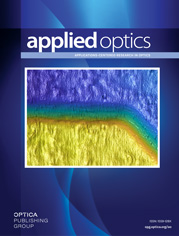Joint Feature Issue of Applied Optics and Journal of the Optical Society of America A
Digital Holography and 3-D Imaging
Submissions Open: 15 June 2017
Submission Deadline: 1 August 2017
This joint feature issue is a continuation of a tradition, since 2007, to highlight current topics in digital holography and three-dimensional imaging. The issue is to follow the conclusion of the highly successful OSA Topical Meeting "Digital Holography and 3-D Imaging (DH)," to be held at Cheju Halla University, Jeju Island, South Korea, 29 May—01 June, 2017. As before, the Topical Meeting provides a forum for science, technology, and applications of digital holographic and three-dimensional imaging and display methods.
Whereas meeting participants are particularly encouraged to submit their work, this feature issue will also welcome papers outside of the meeting that align with the topics of the DH Topical Meeting, such as the science and technology of 3D imaging and display systems, digital holography and holographic microscopy, computer-generated holograms, holographic lithography, holographic remote sensing, biomedical imaging, etc.
Specific topics to be considered include, but are not limited to:
- Advances in Digital Holographic Techniques
- 3D Imaging and Display Systems
- Computer Generated Holograms
- Compressive Holography
- Transport of Intensity
- Quantitative Phase Imaging
- Holographic Lithography
- Digital Holographic Microscopy
- Digital Holographic Optical Processing
- Metrology and Profilometry
- Holographic Remote Sensing Techniques
- Fourier Transform Light Scattering
- Biomedical/Clinical/Medical Applications
- Novel Applications of Digital Holography
- Dynamic Holography and Novel Recording Materials
- Digital Holography in Nonlinear Optical Systems
- Terahertz Generation and its Application to Digital Holography
- Polarization Holography
- Digital Holography for Inspection of Scattering Media
- Novel Software Tools/Algorithms for Digital Holography
- Other Novel Applications of Digital Holography
Scientific and technology innovations are the main factors for submissions to either one of the journals. We encourage authors to give full and in-depth descriptions of the concept, theory, mathematical model, experimental system, and experimental results. A description is in-depth if a reader is able to reproduce the described results by following the paper. Authors are encouraged to submit video multimedia files and other supplemental material, such as code files and links to large datasets, in accordance with OSA's guidelines on supplementary material.
Authors should recognize the difference between AO and JOSA A and select the appropriate journal for submission. AO publishes in-depth peer-reviewed content about applications-centered research. JOSA A is devoted to fundamental developments in any field of classical optics, image science, and vision. If the selection of journal is inappropriate, the Feature Issue editors may suggest transferring to the other journal.
All papers need to present original, previously unpublished work and will be subject to the normal standards and peer-review processes of the journals. The standard AO or JOSA A publication charges will apply to all published articles. To be eligible for publication, the paper needs to add substantial and/or significant new information to the original conference summary. See OSA's guidelines on expanded conference papers for details.
Manuscripts must be prepared according to the usual standards for submission to AO or JOSA A and must be uploaded through OSA's electronic submission system, specifying from the drop-down menu that the manuscript is for the Feature Issue on Digital Holography and 3-D Imaging 2017.
General Joint Feature Issue Editor
Hoonjong Kang, Korea Electronics Technology Institute, South Korea
AO Feature Editors
Byoungho Lee, Seoul National University, South Korea
Tomasz Kozacki, Politechnika Warszawska, Poland
JOSA A Feature Editors
Pascal Picart, University of LeMans, France
Guohai Situ, Shanghai Institute of Optics and Fine Mechanics, Chinese Academy of Sciences, China

